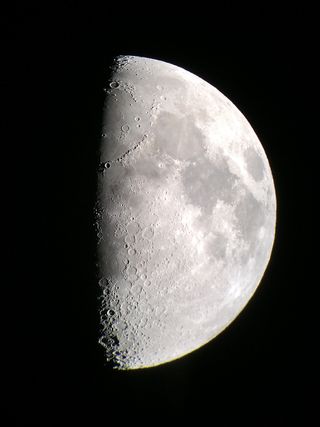Massive space rock impact could have 'instantly' created the moon
Computer simulations of giant space rock impacts suggest an alternative 'instant' origin for the Earth-moon system.

A giant impact may have rapidly placed the moon into orbit around Earth rather than creating a disk of debris from which the moon gradually formed over time, new research suggests.
A highly detailed computer simulation created by Durham University's Institute for Computational Cosmology revealed this alternative origin story for Earth's lunar companion. This new, aptly named 'immediate-satellite scenario' would mean the proto-moon was less molten during its formation and suggest much of the moon formed immediately after a giant impact on Earth.
This more rapid formation theory would also suggest a different internal composition for the moon that could offer an explanation for some of the curious Earth-like characteristics seen in lunar samples.
Related: How was the moon formed?
The moon is thought to have formed around 4.5 billion years ago when Earth was hit by an object from space roughly the size of Mars that scientists have called 'Theia.' It was previously theorized that this impact threw up a field of debris from which the moon gradually formed. A consequence of this would have been that the moon was mainly created by the material provided by Theia as opposed to material from Earth. This idea was challenged when it was discovered that lunar rocks seem to have a composition that is very similar to the mantle of Earth.
The high-resolution results obtained with the impressive computing power of the DiRAC Memory Intensive service called COSMA located at Durham University in England showed an outer layer of the moon rich in material originating from the Earth.
"This formation route could help explain the similarity in isotopic composition between the lunar rocks returned by the Apollo astronauts and Earth's mantle," research co-author and University of Durham physicist Vincent Eke said in a statement. "There may also be observable consequences for the thickness of the lunar crust, which would allow us to pin down further the type of collision that took place."
Get the Space.com Newsletter
Breaking space news, the latest updates on rocket launches, skywatching events and more!

The team's simulation took into account hundreds of different impact scenarios that varied the angle and speed of the Theia collision in addition to varying the masses and spins of the two colliding bodies. It also showed that a large natural satellite like the still-forming moon could survive in close orbit around Earth.
It was previously thought that a rapidly-forming large body close to Earth would be ripped apart by tidal forces emerging from our planet's gravitational influence, thus favoring a slow creation process for the moon.
These new simulations suggest such a body could not only survive tidal forces but could actually be pushed to a higher orbit, delivering it from the threat of future destruction by such forces.
"We went into this project not knowing exactly what the outcomes of these very high-resolution simulations would be. So, on top of the big eye-opener that standard resolutions can give you wrong answers, it was extra exciting that the new results could include a tantalizingly moon-like satellite in orbit," co-author and NASA Ames scientist Jacob Kegerreis said in the team's statement. "This opens up a whole new range of possible starting places for the moon's evolution."
The team's research was published on October 4 in the Astrophysical Journal Letters.
Follow us on Twitter @Spacedotcom or on Facebook.
Join our Space Forums to keep talking space on the latest missions, night sky and more! And if you have a news tip, correction or comment, let us know at: community@space.com.

Robert Lea is a science journalist in the U.K. whose articles have been published in Physics World, New Scientist, Astronomy Magazine, All About Space, Newsweek and ZME Science. He also writes about science communication for Elsevier and the European Journal of Physics. Rob holds a bachelor of science degree in physics and astronomy from the U.K.’s Open University. Follow him on Twitter @sciencef1rst.
